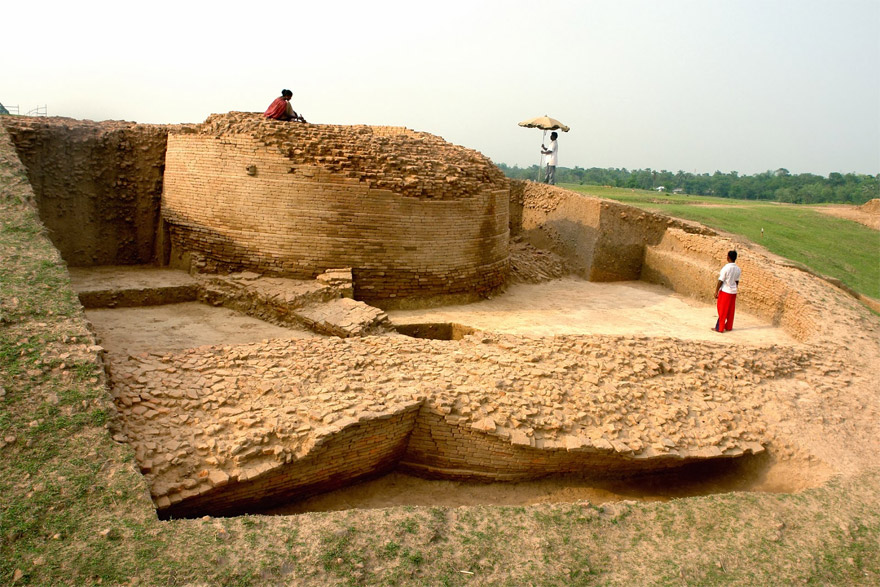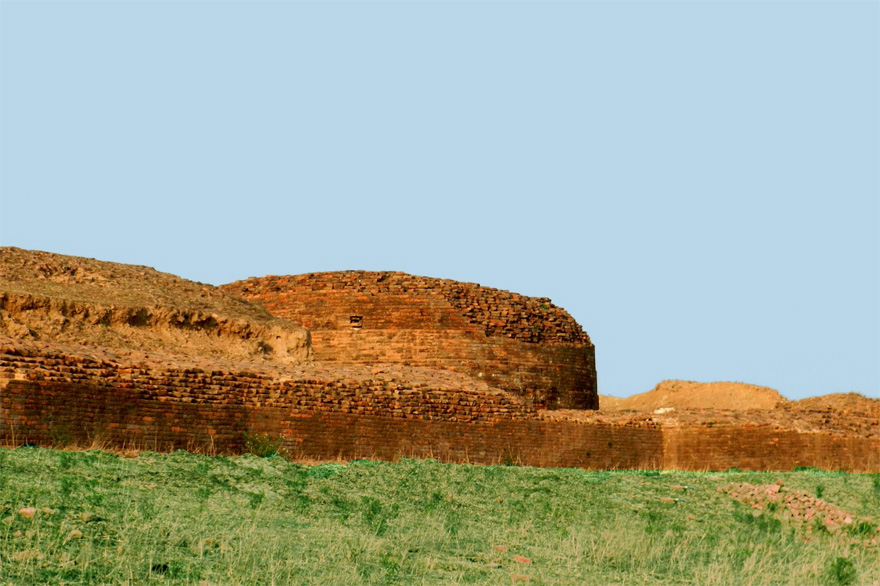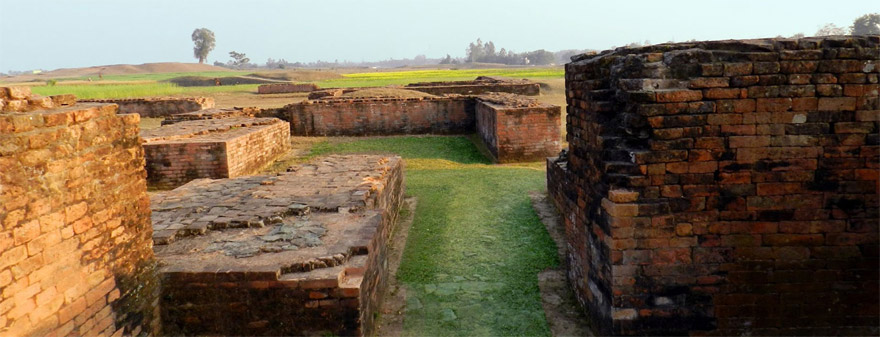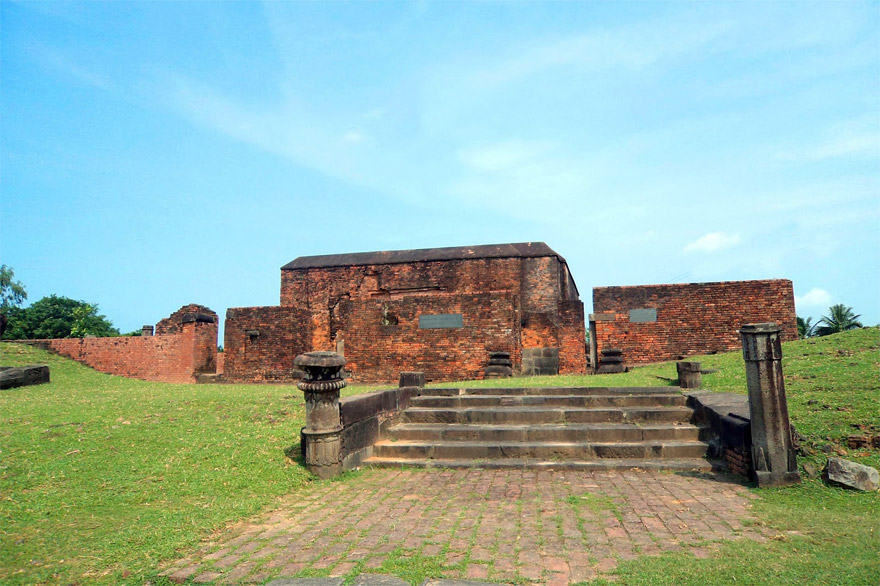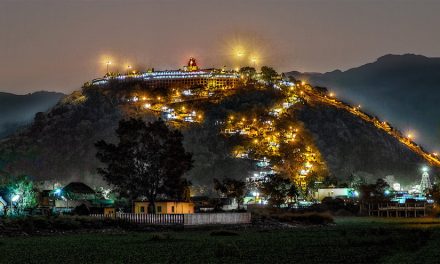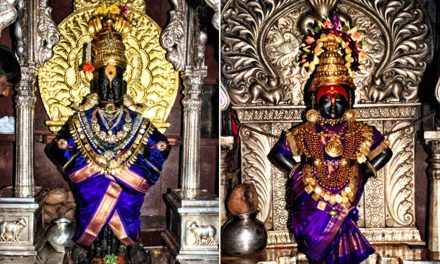The district of Dakshin Dinajpur is home to many archeological and temple art sites of great interest to the Vaisnavas. For example, Dakshin Dinajpur is the place where Lord Krsna’s son Aniruddha fled with Usha, resulting in the battle between Krsna and Bana.
A part of the undivided Dinajpur district of erstwhile Bengal, it was known as Pundra Vardhan Bhukti in ancient times. West Dinajpur District was created in 1947 at the time of partition of India, with the rest of the Dinajpur district being apportioned to Bangladesh. According to Brihath Katha Kosh, the famous Jain Guru of the Maurya Emperor, Chandra Gupta was the son of a Brahmin of Devakota in Pundra Vardhan. The eastern portion of Dinajpur was known as Panchanagari and Devakot was the capital, the ruins of which are still found in and around Bangarh in Gangarampur, PS.
[wp_ad_camp_1]
In the centre or Bangarh is a large heap of bricks which were once the palace of Raja Bana. At Shivbati, a little distance from the northeast corner of the city, more heaps of brick are the ruins of a temple of Virupakshya Shiva. King Bana was a worshipper of Lord Shiva, and he excavated Tapan Dighi in Tapan PS to offer tarpan to Shiva.
About half a mile west from the northern end of the palace was the house where Usha, daughter of King Bana, used to live. She was in love with Aniruddha, the son of Krishna. Aniruddha fled with Usha, and the road he followed is still known as Ushaharan Road. Usha’s love for Aniruddha brought about total destruction for her father and his empire, as memorialized in the place called Narayanpur, on the other side of river Brahmani, where the great battle between Krishna and Bana is said to have taken place.
The demon Bana was the eldest son of Bali, who in turn was the grandson of Prahlad. Bana was a great devotee of Siva, and Siva offered him his own representative in the form of a natural linga for worship (banrchartham krtam lingam.
About 10 miles away from Bangarh is a place called Kardaha in Tapan P.S. Here the palms of Bana were cut in the battle by Krishna. They are said to have fallen here, where the funeral of Bana also took place. In the riverbed of the Tangon, which now houses the Bangshihari Police Station, the stone relics of another ancient temple are visible when the river water recedes.
A good number of places in the Dakshin Dinajpur district are associated with the epic stories. In Mahabharata it is said that the Pandavas, going incognito, took shelter in the palace of King Birat. The ruins of this place are found at Bairhatta, a village in Harirampur PS. It’s also said that here Kichaka, the army chief of King Birat, was killed by Bhima, when the former tried to establish illicit relations with Draupadi. A tank at Bairhata is still called Kichaka Kunda.
Dehaband, an area full of mounds about 15 km away from Birhatta, is said to be the location of the palace of Kichak. An ancient shami tree, a unique specimen in this region, is seen at the entrance of the village. Here, Nakula kept the arms of the Pandavas hidden before entering the Palace.
A village in the locality has been named Pancha Bhaya (five brothers) after the Pandavas. A number of places like Karandighi, Karnajora, and Karanji in the neighbouring area memorializes the Pandavas’ association with the great warrior Karna.
During the Mauryan period Jainism flourished in this area. The river Punarbhava was one of the most important river routes from Pundra Bardhan Bhukti to Pataliputra and Indraprastha at that time. The area became an important centre of Jainism, and the Jain Prajna Pana mentions the name of Kotivarsa.
In the 6th and 7th century AD, many of the kings preceding Harshavardhan were devotees of the Sun god, Lord Surya, and there is abundant evidence of sun worship in this region. In Tapan thana, an old sandstone image of Surya is kept, which belongs to perhaps the 7th century AD. At Bairhatta, another piece of stone carved in the image of Surya was recovered.
More recently, during a re-excavation of Bhabna Dighi at Kokil village in Harirampur Police Station by the Panchayat in June 1994, a very beautiful stone image of the Sun god was discovered. This one belongs to an earlier period, around the 7th century AD.
Another beautiful black stone image of Surya about 3½ ft. high was recovered from criminals, and is now being kept at Tapan Thana building. It is an exquisitely beautiful image, perhaps belonging to the Gupta period.
According to Ramcharita Manasha, Barendra Bhumi was the homeland (Janakbhu) of the Palas. Gopal, the first king of the Pala dynasty, is said to have hailed from here. Reference may be made to the Pancha Gour-Gour empire of Emperor Dharma Pal. In fact, the gradual extension of Pundra Vardhan Bhukti began under the Palas. It comprised number of Mandals, and each Mandal is comprised of several vishayas. Kotivarsha, mentioned earlier, was a Vishaya situated on the river Punarbhava. It has also been mentioned in the inscriptions as the most important Vishaya.
Though Dharma Pala (c. 77O-810 A.D.) was a great patron of Buddhism and set up more than fifty Buddhist monasteries in different parts of his empire, he was not averse to Hinduism. He himself established a four-faced Shiva image at Buddha Gaya. At Aminpur village in Kushmandi Police Station, a five-faced Ban Linga has been discovered. At Dehabandh village in Kushmandi PS, one Shiva Linga is seen on the roadside along with four goddesses with folded palms engraved on four sides. It is a unique image belonging to the Gupta age. A similar sandstone image has been kept at the District Library. Other beautiful sculptures from the Gupta period can be seen at the Library Museum.
A passage in Raj Tarangini refers to the existence of a Kartikeya Temple in Pundra Bardhan, from the 8th century AD. In Kushmandi another black stone Kartikeya image has been discovered, likely belonging to a little later period.
Several mounds at Dhampara and Danagram indicate the existence of various other historical sites in the area. The ruins of the famous Jagdalla Mahabehar mentioned in Ramcharita can still be seen under thick bamboo groves in a village called Jagadalla in Banshihari Block.
The Buddhist scholars who became famous in Tibet, like Bibhuti Chandra, Danshila, Mokshakar Gupta and Subha Kar Gupta, were associated with this Mahabehar. It is said that Sanskrit texts were actually translated to Tibetan at Jagadalla. The presiding Deity here was Abolokiteswar. This famous centre of Buddhist culture and education was demolished by Bakhtiyar Khilji in 12O2-03 A.D.
After the death of Dharma Pal, Deva Pal reigned for about forty years. He constructed the Somepuri monastery which is near Paharpur. In Tapan Police Station, a few Buddha images have been found, one of which can be seen at the College Museum. In Kumarganj Police Station one village near Daudpur is named Buddha Nath Dham. Quite a large number of Buddhist images representing the Mahayana pantheon and belonging to the Pala period have been found in different parts of this district.
The decline of the Pala dynasty began in the later half of the 9th century A. D. For some time the Pratihar got control over North Bengal. In Dinajpur (now in Bangladesh) an inscription pillar of the Pratihar King, Mahendra Pal, son of King Bhoja, has been found. A prosperous village on the bank of river Srimati in Itahar PS is called Pratirajpur
Narayan Pal (C. 854-908 AD) some how was retained in Gour region. A record refers to the construction of a Shiva temple by Narayan Pal somewhere near Punarbhava. Gopal-II’s inscription on copper plates have also been found in the district.
Mahipal (C988-1038 AD) was famous for his construction activities. He restored and repaired many monasteries and Buddhist monuments. Traditions have associated the name of Mahipal with a number of Tanks. One such big tank called Mahipal Dighi can be seen in Banshihari Block. At that time big monasteries existed at Tapan and Vikahar in Tapan PS, Devikot in Gangarampur Police Station, Dehabandh and Amalahar in Kushmandi P.S.
Tantrik Buddhism flourished in Bengal at this time under the Chandras. King Gopi Chandra belonged to this dynasty. Atish Dipankar is said to have been born in that royal family. The kingdom of Nayapal was invaded by King Karnya from the west. Karnya defeated the Pal king and destroyed many monasteries. Dipankar Sri Jnan was then in the court of Magadha. He made sincere efforts to bring peace, and through his good offices, a treaty was concluded. Dipankar left India for Tibet some time in 1038-1042 AD.
During the reign of Mahipal-Il (C1072-75 AD) Divyok organised a revolt against the Palas. He usurped the throne and made his position secure in Barendra Bhumi. Rudaka and Bhima succeeded, one after another.
Alter Vijay Sen, Ballal Sen became the King of Bengal. His dominion comprised, among others, Barendra Bhumi. Lakshman Sen had his second capital at Lakshmanavati in Gour. Biswarup Sen was also called Goureswar.
The early Sen kings were followers of Shaivism. A few beautiful black stone Shiva Parvati images have been recovered in the District. One such image can be seen at the District Library museum. Another exquisite image has been kept at Balurghat Treasury.
The royal seal of the Sens was engraved with the image of Sadashiva. A few beautiful images of Ganga and Yamuna have also been found in the District. A relief depicting a lady lying with a child by her side, attended by females and with miniature figures of Shiva at the top (found at Gangarampur), are thought to represent either the scene of Krishna’s nativity or the birth of Kartikeya (Kumar Sambhava).
The later rulers of the Sen dynasty were Vaishnavas. Hundreds of Vishnu images built of black stone, exquisitely decorated, have been found in almost every prosperous village in the District. The last addition to such collection is the black stone Deity found in village Kaigram in Balurghat Police Station, in March 1994. It has been kept at Balurghat Thana.
Another beautiful piece depicting Vishnu, measuring 32 inches by 16 inches, was discovered during re-excavation of Bhabna Dighi in Harirampur Police station. This piece has been kept in the Banshihari Block office.
The last king of Sen dynasty, Keshab Sen, came to power in 1225 AD. He was a Sun worshiper and some Sun images of his time have been found in the District.
Mention may be made about a few black stone images of the Sen period, which stand unique in the locality. One such image is that of Ardhanarishwar, recovered from Dehabandh, now kept at Kushmandi Block office. Another interesting image is that of Varahi (the goddess associated with Lord Varaha) recovered from Bairhatta and now kept at Harirampur Thana.
Broken pieces of a Chandi image with Godhika were found at the bottom of Bairhatta and a huge, eight foot high image believed to be Mahismardini (although it may be a Buddhist goddess) are found lying at Bhikahar. These deserve special mention.
At Sarbamangala village about 10km away from Shivabati in Gangarampur PS, one black stone eight-armed Mahismardini image, about 2 1/2 ft. high, and another eighteen-armed Chandi image, about 2 ft. high, are kept in a mandir. Under a tree in front of the mandir, a number of broken stone images of Mahismardini, Surya and Vishnu are found.
It appears that a sculptor of the late Sen period lived here. It is also presumed that there were some sculptor families in this area in ancient times. The village now called Patharpunji in Tapan PS indicates that stones were brought from Rajmahal hills by boat, up the river Punarbhava. The stones were likely stored in that village and in other places, used for stone carving by the local artists.

